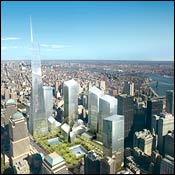
The designs tell the tale. During the past year, Daniel Libeskind visibly lost control of the 1,776-foot-tall Freedom Tower. He stood by as David Childs, the architect selected as his “collaborator” by the tower’s developer, Larry Silverstein, turned his asymmetrical gesture into a tidy half-twist—a dull, piecemeal plan now mired in its own authorship controversy.
This year, everyone was talking about architecture, and New Yorkers had any number of celebrity architects dangled before them—Santiago Calatrava, Sir Norman Foster, Frank Gehry, Charles Gwathmey, Renzo Piano, Sir Richard Rogers, not to mention Yoshio Taniguchi and the new Museum of Modern Art. Libeskind began as the poster boy for the trend, and ended as its casualty. Which only seems like a paradox. In fact, it’s a cautionary tale for small architects trying to leverage their talent and get big. Libeskind, despite the notoriety he gained for his zigzag Jewish Museum in Berlin, was out of his league. He was a name brand in name only.
Libeskind had only a small office. He had never designed a skyscraper. His fame was for his talk. When all eyes were on him, he told a compelling story, digitized a romantic new skyline, but he didn’t have the support to make him the equal of his reluctant client. He also didn’t have the celebrity to push back, to make threats, to generate sympathy.
Architecture is a service industry, and its true celebrities are those who have served the powerful repeatedly and well. Silverstein insulated himself from charges of Philistinism by hiring, for future towers, three architects who combine the style of Libeskind and the expertise of Childs: Foster, Fumihiko Maki, and Jean Nouvel. If Foster’s twinned “kissing towers” had won the original competition, his stature, experience, and 500-person office would have made most of Silverstein’s objections to Libeskind ridiculous. If Foster had gotten into a power struggle, he could have made the developer seem petty, rather than the architect.